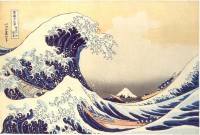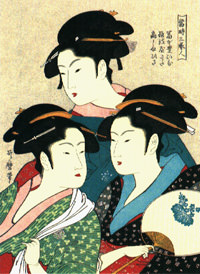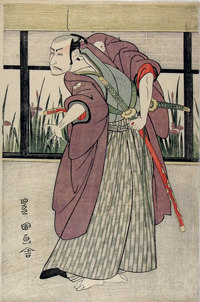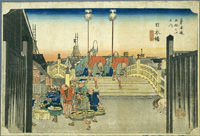
Wood-block prints (Ukiyoe in Japanese) are perhaps one of the most recognizable art forms around the world, and are instantly recognizable worldwide as being uniquely Japanese. Because many of these prints were based on everyday life, they provide a view into Japan’s past.
Around the world, art has been reserved for the elite. However, because Ukiyoe were mass produced, this allowed the artists to sell the prints at reduced costs. This, combined with the subject material of the prints, made Ukiyoe very popular with the middle and lower classes of the Edo period (1600 – 1868). Today there are many avid collectors, with more every day. In addition, they were enthusiastically collected by impressionist artists such as Monet, Degas, Van Gogh and Toulouse-Lautrec, whose work was profoundly influenced by them.
Ukiyoe – History of Ukiyoe
During the 16th century, Japan was embroiled in a 100 year civil war. Many warlords fought with each other to gain more land and power. This Sengoku Jidai, (Warring States Period) gave way to peace in 1600 when Tokugawa Ieyasu, the first Tokugawa Shogun, was able to unify Japan under one rule. The Tokugawa Shoguns ruled Japan from 1600 to 1868, and were able to maintain a peaceful environment for this entire period. This ensuing peace allowed more time and money for the arts.
The first Ukiyo-e appeared as illustrations in the storybook Ise Monogatari (Ise Story) around 1650. Around 1660, Hishikawa Moronobu persuaded his publisher to issue prints individually, which became a huge success. Hishikawa signed his prints as well, which announced to the world that he took himself seriously as an artist, with many other artists following suit.
During the early eighteenth century, improvements were made to the paper quality. Mica was added to the background and glue was added to black paint for shine. It was during this time that triptychs were first introduced as well. Up until the middle of the eighteenth century, prints were made in black and white, and color was added after the fact manually. The first truly multi-colored prints (called Nishiki-e, or ‘brocade picture’ in Japanese) appeared around 1769. An Edo artist, Suzuki Harunobu published a series of prints in which the colors were either enclosed by an outline, or formed hard edges. These prints were an instant success.
Subject Material

During the Edo period, the Japanese turned their attention to more hedonistic pleasures. The Tokugawa Shoguns, wanting to control these activities, dictated that pre-defined pleasure quarters be created. The most famous of these was the Yoshiwara District, which was located just north of today’s Asakusa District in Tokyo. Ukiyo-e literally translates to “Pictures of the Floating World”. The Floating World referred to life in the pleasure quarters.
Publishers soon discovered that the courtesans from the pleasure quarters were popular subjects. Many collected these prints, wishing they could afford the services of the courtesans. Prints of explicit sexual nature were also popular. However, courtesans were more often than not depicted showing off their extravagant kimonos like a fashion model or demonstrating the latest hairstyle.
“Floating World”
During the Edo period, the Japanese turned their attention to more hedonistic pleasures. The Tokugawa Shoguns, wanting to control these activities, dictated that pre-defined pleasure quarters be created. The most famous of these was the Yoshiwara District, which was located just north of today’s Asakusa District in Tokyo. Ukiyo-e literally translates to “Pictures of the Floating World”. The Floating World referred to life in the pleasure quarters.

Publishers soon discovered that the courtesans from the pleasure quarters were popular subjects. Many collected these prints, wishing they could afford the services of the courtesans. Prints of explicit sexual nature were also popular. However, courtesans were more often than not depicted showing off their extravagant kimonos like a fashion model or demonstrating the latest hairstyle.
Kabuki
Kabuki theater, born on the banks of the Kamo River in Kyoto during the early Edo period, quickly became wildly popular all across Japan. Kabuki actors became famous, and were idolized in much the same way Hollywood stars are idolized today. Publishers soon discovered that people wanted to collect prints of their favorite Kabuki actors depicting their favorite roles, or participating in everyday activities such as walking in the park.
Travel
During the Edo period travel became popular. Some of this travel was dictated by the Tokugawa Shoguns as part of the “Alternate Attendance” in which Daimyos (feudal lords) were required to travel to Edo to meet with the Shoguns. But much of this travel was by common Japanese, such as performing pilgrimages. Prints depicting images from around Japan soon became very popular.
Shunga

Shunga literally means springtime pictures. Shunga prints were sexually explicit, and most Westerners would categorize it as pornography. Shunga prints were produced and sold individually, but were more commonly sold in book form.
Shunga prints were popular for many reasons. One was certainly the enjoyment of viewing erotic pictures. But they also served as sex education for young men and women. It was even tradition that a bride of a Daimyo included a collection of Shunga prints together with their wedding furniture.
Because Shunga prints were so popular and lucrative, almost all of the artists made these prints at one time or another. But because of censorship laws prohibiting these prints, few artists ever signed them. The censorship laws were seldom enforced, but most artists considered it wise to publish them anonymously. It is widely thought the tradition of Shunga prints continues in the explicit sexual nature of manga and anime in today’s Japan.






Well I sincerely liked studying it. This article offered by you is very effective for proper planning.